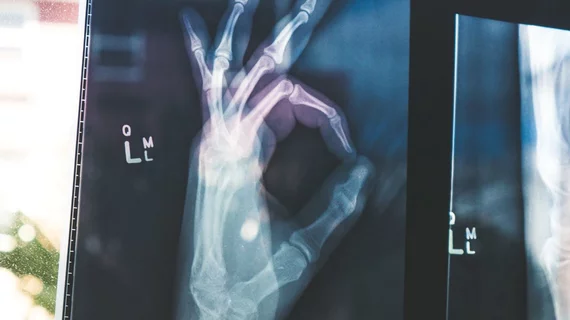Artificial intelligence shows promise spotting small bone fractures invisible to humans on X-rays
Artificial intelligence may be able to spot small fractures that are invisible to radiologists and other human observers, according to a new study published Thursday in JAMA Network Open.
Scaphoid breaks are the most common fracture in the wrist, but upward of 20% can’t be seen on the initial radiograph. Such misses can lead to wrist arthritis and debilitating pain affecting productivity and quality of life.
To address this concern, scientists with the University of Michigan and the Taiwan-based Center for Artificial Intelligence in Medicine designed a deep convolutional neural network to spot small fractures. Test-driving it on a set of scaphoid X-rays, the AI model was able to identify more than 90% of occult fractures, they reported on May 6.
“It achieved high sensitivity and specificity, suggesting that [deep convolutional neural networks] can be trained to reliably detect fractures in small bones,” concluded Alfred Yoon, MD, a plastic surgery resident with Michigan Medicine, and co-authors. “In addition, this study found that the DCNN could detect occult fractures that are not readily visible to physicians. This enhanced diagnostic capacity can help to solve medical problems with high monetary or quality-of-life costs and improve fracture care,” they added.
To build their AI model, Yoon and colleagues utilized a set nearly 12,000 radiographs obtained in Ann Arbor, Michigan, and Taipei, Taiwan, between 2001 and 2019. Roughly 5,000 included a scaphoid fracture while the other 7,000 did not, with 2,300 used for testing. In that set, the neural network achieved sensitivity of 87%, specificity of 92%, and an area under the operating curve of 0.955 in distinguishing images with scaphoid fractures. The final two-stage AI examination identified 20 out of 22 cases successfully, for a nearly 91% success rate.
“AI can recognize complex image patterns and mathematical motifs that are not discernable to human eyes, facilitating detection of occult fractures,” Yoon and colleagues wrote. “By contrast, trained radiologists assess new images based on knowledge of patterns learned from prior experience, which are vulnerable to human subjectivity. If DCNNs can assist physicians in reliably diagnosing occult fractures and elucidating obscure findings in other imaging modalities, immeasurable benefits to both patients and healthcare delivery could be achieved,” they added.
You can read more of the study in JAMA Network Open here.

